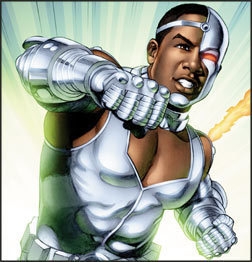DC Comic’s Victor Stone, also known as Cyborg, is one of many superheroes who had his powers thrust upon him without warning.
Victor was visiting his parent’s laboratory when an accident occurred, killing his mother and leaving him severely maimed. In order to save his life Victor’s father rebuilt his body with mechanical parts designed to mimic, and even enhance, the areas of his body that were destroyed. By doing this Victor’s father turned him into a cybernetic organism, or cyborg for short.
A cyborg is a being which has both artificial and natural parts, and the term generally refers to a human being who has been modified through the implantation or attachment of mechanical parts. In Victor Stone’s case, his cybernetic modifications provide him with built-in weapons, superhuman strength, enhanced senses, and extraordinary resistance to damage, among other things. The cybernetic systems that are becoming increasingly common in the modern world are not yet advanced enough to give people superhuman abilities, but they currently help save lives and help heal people who have suffered serious injuries and debilitating diseases.
Cybernetics is a very broad topic that encompasses many avenues of research. This article will focus on the medical role of bionic devices in the present and near future. Advanced bionics that provide people with enhanced abilities will be discussed in a later article.
Artificial limb replacements have existed for centuries, and include such commonly known devices as the pirate’s hook and peg leg, as well as less widely known examples. For the most part modern cybernetic devices continue this trend and are created to allow people to recover from injuries, disease, or genetic disorders. Examples included life saving machines such as pacemakers, cochlear implants and advanced artificial limbs. The difference in definition between prosthetics and bionic or cybernetic systems is somewhat murky, but generally centers around the idea that a bionic replacement more closely mimics the functionality of the part that is replaced. In some cases a bionic body part can even offer improved performance over the original organic version, while prosthetics offer assistance but do not have the full functionality of the original. By this definition a peg leg or hosmer hook prosthetic arm would be a prosthetic, while more advanced systems like this one from Vanderbilt University would be considered a bionic.
People have been attempting to provide replacement limbs for those who have been injured in wars or accidents for a long time, and recent advances in technology have brought that goal closer to fruition. Advancements in robotic miniaturization have enabled more advanced bionic limbs to be built, and made them lighter and more natural to use than a large and clunky mechanical replacement would be.
Another area of research, which is making more advanced bionic limbs possible involves improving the control systems that allow their users to interface with them. Many prosthetics are controlled either by cables that run to another part of the body or a set of controls. The prosthetic’s wearer gains back some of the functionality of the missing limb, but must control it with another part of their body and so it is far less useful than the natural limb. In order to make replacement limbs more useful researchers have developed prosthetics that detect movements of the remaining muscles in a damaged limb and move accordingly. Limbs of this type vary in complexity, ranging from using muscles to trigger switches to detecting the electrical signals sent from the muscles moving and reacting accordingly. Although these systems are an amazing step forward they are still not as natural as the organic original. The challenge of creating an artificial limb that works just as naturally as a living one has been taken up by the United States’ Defense Advanced Research Projects Agency and researchers at John Hopkins University in Baltimore. The bionic replacement arm they constructed works by reading signals directly from the wearer’s nervous system, allowing it to function almost as well as a natural limb after a short calibration period.
Research continues on creating artificial replacements for major organs such as damaged hearts, livers, kidneys, and lungs. As these technologies become more developed it will lessen the current reliance on transplants to replace damaged organs, and will allow a great many more people a chance at recovering from grievous injuries.
Scientists are also working to help people who are handicapped in other ways. Cochlear implants are devices that can enable people who have gone deaf, or young children who have been deaf from birth, to hear. These astounding pieces of technology are quickly becoming more common, and consist of an external microphone assembly that transmits sound into a device within the person’s inner ear that allows them to hear it. In a similar way researchers at the Retina Implant company are working on a microchip that is implanted on the back of the eye and allows people with certain types of blindness to see. So far the implants allow people to detect light and make out the outlines of objects, but even though these devices are in their infancy they carry the promise of an eventual cure for blindness. Modern cochlear and retinal implants are forced to rely on external components in order to function, but as these technologies become more advanced they will become smaller and eventually will be fully integrated into the user’s body.
As the technology required for artificial organs and implants becomes more common and cheaper to produce it will also lead to the development of implants to counteract other ailments, with implants even being suggested to help cure diseases of the brain like Parkinson’s and Alzheimer’s.
As this technology continues to develop the list of ailments that can be treated with bionics will increase as well, and someday it is likely that every major hospital will have a cybernetics unit dedicated solely to providing implants to heal people from crippling injuries and diseases and allowing them to return to their lives.

